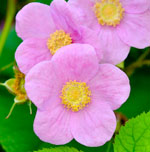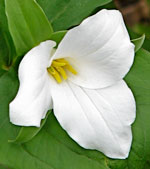Happy Earth Day! One of the best ways to celebrate is to preserve biodiversity by planting native plants! And we hope you enjoy the updated look and organization of the newsletter. Our upcoming program this Sunday
 "Before manicured lawns, with their chemicals, mowers, and blowers, there were ecological meadows, with their butterflies, birds, and bees. Catherine Zimmerman's Urban & Suburban Meadows reintroduces readers to the beauty and biodiversity of the meadow and reminds them of the intricate connections between wildlife and native plant communities that serve as both food source and habitat. Whether restoring a small urban pocket garden or reclaiming an acre of suburban lawn, this beautifully photographed book will compel readers to plant these living landscapes. Zimmerman provides both the inspiration and the thoughtfully developed and comprehensive practical steps necessary for success." "Before manicured lawns, with their chemicals, mowers, and blowers, there were ecological meadows, with their butterflies, birds, and bees. Catherine Zimmerman's Urban & Suburban Meadows reintroduces readers to the beauty and biodiversity of the meadow and reminds them of the intricate connections between wildlife and native plant communities that serve as both food source and habitat. Whether restoring a small urban pocket garden or reclaiming an acre of suburban lawn, this beautifully photographed book will compel readers to plant these living landscapes. Zimmerman provides both the inspiration and the thoughtfully developed and comprehensive practical steps necessary for success."~ Penny Lewis, Executive Director Ecological Landscaping Association Copies of this helpful book are available at the library, but at our April meeting, we're going to screen Zimmerman's video that shows how to create a meadow. Doug Tallamy and others contribute their expertise on the video. Zimmerman "combines her expertise in filmmaking, storytelling, environmental issues, horticulture and organic practices to offer meadowscaping as a lawn alternative." See a trailer for the video. WHEN: Sunday April 27 at 2:00 pm WHERE: Liverpool Library ( Directions) NOTE: For this meeting, we'll be in the smaller Sargent meeting room
Our meetings are free and open to the public. Come and bring a friend!  Janet Allen, President, HGCNY
|
|
Surprising things about spring ephemerals
|
 | Bloodroot (Sanguinaria canadensis) with a bee
|
Bumble bees are some of the most important pollinators of wildflowers. Not many other insects' tongues can reach into flowers such as dutchman's breeches! Other smaller solitary bees are important for other spring ephemerals. Once pollinated, some plants such as bloodroot and trilliums, depend on ants for seed dispersal. The plants' seeds have a nutrient-rich fatty appendage called elaiosomes that ants love. After carting off the seed, they eat the elaiosome, and leave the actual seed "planted" in its new location. Mayapples have an especially interesting way to plant their seeds. After ripening, the heavy mayapple fruit bends to the ground where it attracts box turtles. The turtles eat the fruit and by the time the seeds are excreted, the turtle has traveled to a new area for the seed to sprout. Read more about the fascinating lives of some of our beautiful spring wildflowers at the Ecological Landscaping Association. And if you have some woodland-like areas (or can re-create this native Northeast area) be sure to plant some of these beautiful Northeast natives.
|
 |
 | | Extent of glaciers |
When people first hear about the earthworm "invasion," they can't believe it. We've heard all our lives about the benefits of earthworms. But for those areas that were covered by glaciers (which includes Central New York), earthworms aren't native to our area. And the reasons why earthworms may benefit our vegetable garden -- such as "mixing" the compost into the soil -- are the reasons why they are bad for our forests. By destroying the "duff" layer of the forest soil, grazing on plant roots, and eating seeds, earthworms are harming native plants in our hardwood forests. What to do? * Fishermen shouldn't discard worms in the forest * Don't transport mulch or compost that may contain earthworms or cocoons * Freeze vermicompost at least a week before using * Wash tires of cars, ATVs etc Learn more from the Great Lakes Worm Watch and from a Scientific American article
|
|
Pussy willows and Bumble Bee Watch
|
 | | A bumble bee queen enjoying a pussy willow (Salix discolor) |
Bumble bee queens are finally emerging after the long winter and will be starting new colonies. (The queens are the only ones that live over the winter, which is why bumble bee colonies never grow to the size of honey bee hives.)
We generally associate pussy willows with the beautiful soft gray catkins that cover the shrub, but the plant is equally or even more beautiful when the catkins flower.
And it's one of the few plants blooming in early spring for bees large and small to gather nectar and pollen. They love it!
Bumble Bee Watch
And now that bumble bees are out and about, we can participate in a citizen science project called Bumble Bee Watch, a collaborative effort to track and conserve North America's bumble bees. You can:
- Upload photos of bumble bees to start a virtual bumble bee collection;
- Identify the bumble bees in your photos and have your identifications verified by experts;
- Help researchers determine the status and conservation needs of bumble bees;
- Help locate rare or endangered populations of bumble bees;
- Learn about bumble bees, their ecology, and ongoing conservation efforts; and
- Connect with other citizen scientists.
For more information and to participate, go to Bumble Bee Watch.
|
 | Jewelweed: Worth the small effort to weed out the extra seedlings that will arrive!
|
We've started seeing some birds return to our area, but we're still awaiting some of our summer favorites, including the ruby-throated hummingbird. You can track their progress on a few websites as people report their sightings: Journey North and Hummingbirds.net. They're getting closer! Many people prepare for their arrival by putting out sugar water in nectar feeders, but observe a few precautions: * Never put red food coloring in the nectar or buy colored nectar (though the feeder itself can be red) * Never use honey or artificial sweeteners * Keep them scrupulously clean Read more of the details from Cornell Lab of Ornithology... Native plants are even better!It's fine to prepare for early arrivals or late departures with feeders, but given the high maintenance required for hummingbird health, many people find it much easier to provide native nectar plants that provide them with excellent nutrition. A few of their favorites include:Trumpet creeper ( Campsis radicans) Beebalm ( Monarda didyma) Trumpet honeysuckle ( Lonicera sempervirens) Red columbine ( Aquilegia canadense) and Jewelweed ( Impatiens capensis) See the rest of the Top Ten list at Operation Rubythroat and read more about hummingbirds in our habitat garden at OurHabitatGarden.org...
|
 |
|
|
|
Start planning for our fall plant sale
|
 | | Flowering raspberry (Rubus odoratus) |
It's not too early to starting thinking of our fall plant sale. As you observe your plantings this spring and summer, note which plants you'd like to donate to our sale. Consider potting them up early so they're established in their pots in time for our sale on Sept. 13. Our plant sale profits fund this newsletter.
|
Upcoming
Habitat Gardening Presentations
|
I'll be doing some presentations that are FREE and open to the public.
Tues. Apr. 29
6:30 pm:
Our Future Flies on the Wings of Pollinators
Northern Onondaga Library at Cicero
8686 Knowledge Ln. Cicero.
Tues. May 13
6:30 pm:
Creating a Bird-Friendly Yard
Northern Onondaga Library at Cicero 8686 Knowledge Ln. Cicero.
Sat. June 21
10:00 am:
Creating a Monarch Waystation and a Butterfly-Friendly Landscape
Northern Onondaga Library at Cicero 8686 Knowledge Ln. Cicero.
|
|
Upcoming events at Baltimore Woods
|
 | | Trillium |
April 26 9 am - 1 pm:
Eat Your Enemy Annual Earth Day Event - Be part of a special task force pulling this invasive, then be treated to a unique and deliciouslunch featuring garlic mustard as the main ingredient! FREE, but register by calling The Woods at 673-1350.
April 26 1 pm - 3 pm:
Dragonfly Pond Watch - Take part in scientific research while catching dragonflies! A great family event. (Fee)
April 26, 27 2pm - 3pm
Weekend Wildflower Walks - guided tours
Donations appreciated.
|
Since HGCNY is a chapter of the national organization Wild Ones, when you become a member of Wild Ones, you're automatically a member of HGCNY, too. And since Wild Ones is an official not-for-profit, your membership is tax-deductible.
It's easy to become a member, receive the bimonthly Wild Ones Journal, and support our mission.
|
|
As more of us participate on our Facebook page, this will become a useful resource for asking (and answering!) local HGCNYers' questions about habitat gardening.
|
|
Our Habitat Garden website
|
 Visit Our Habitat Garden website for information on providing habitat, earth-friendly gardening practices, plants, and various creatures here in Central New York. |
Visit Our Edible Garden website to see an example of a local vegetable and fruit garden. An edible garden is a perfect complement to your habitat garden.
|
|
 |
|